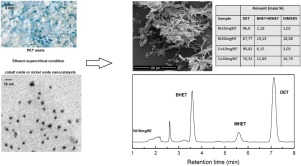The Journal of Supercritical Fluids ( IF 3.4 ) Pub Date : 2019-12-06 , DOI: 10.1016/j.supflu.2019.104715 Janaina Rodrigues Fernandes , Lídia Pereira Amaro , Edvani Curti Muniz , Silvia Luciana Favaro , Eduardo Radovanovic

|
The depolymerization of the PET in supercritical conditions using ethanol and catalyzed by cobalt and nickel oxides was enough for the recovery of the DET monomer, allowing yields close to 100 % depolymerization. The formation of DET in the depolymerization process was characterized by 1H-NMR, DSC, FTIR, SEM, and HPLC. Cobalt oxide and nickel oxide were obtained through the Pechini method and characterized using DRX, SEM, and TEM. A factorial design 22 with a duplicate center point was applied to evaluate the reaction time and amount of the catalyst effects on yield. Through analysis of response surface methodology (RSM), the highest degree of PET conversion (%) was obtained in 90 min reaction time and a smaller amount of catalyst (10 mg) through analysis of response surface contour. The smaller quantity of catalyst was sufficient to accelerate the process of depolymerization reaching almost 100 % yield, obtaining the monomer DET as the main product.
中文翻译:

金属氧化物纳米粒子催化的超临界乙醇条件下的PET解聚
PET在超临界条件下使用乙醇进行解聚,并由钴和氧化镍催化,足以回收DET单体,从而使收率接近100%。用1 H-NMR,DSC,FTIR,SEM和HPLC对解聚过程中DET的形成进行了表征。通过Pechini方法获得氧化钴和氧化镍,并使用DRX,SEM和TEM对其进行表征。析因设计2 2用一个重复的中心点来评估反应时间和催化剂用量对产率的影响。通过分析响应面方法(RSM),通过分析响应面轮廓,可以在90分钟的反应时间内获得最高的PET转化率(%),并获得较少的催化剂(10 mg)。较少量的催化剂足以加速解聚过程,几乎达到100%的收率,从而获得了单体DET作为主要产物。









































 京公网安备 11010802027423号
京公网安备 11010802027423号